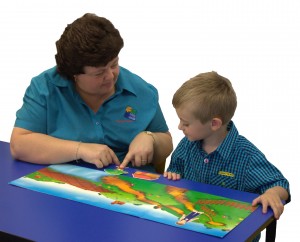
Earlier we looked at teaching your child to answer the simplest level one questions. Level two is the second most simple of the four levels of questions and typically develops in three year olds. At this level children talk about the things they see, hear and touch but focus in on specific details as they answer these questions.
Level two questions include:
- Choosing things by function “Which one can cut?”
- Naming functions “What do we do with this?”
- Describing differences “how are this one and this one different?”
- Selecting people by actions “Show me a boy who is running”
- Doing a series of actions in order “Do this, then do this”
- Finding items with two characteristics “Which one is round and red?”
- Describing actions in a scene “What is happening in the picture?”
- Recalling information heard, such as in a statement or simple story “what.., who…where…?”
- Naming functions and characteristics of objects “what is this part for?”
To help a child learn to answer questions:
- give lots of practice with one question type before moving on
- keep your questions short, clear and specific
- give only a few choices, two or three pictures or objects to start with, and add more as your child learns
If your child does not know the answer you can:
- Rephrase your question as a question from a simpler level then try the question again
- Give them a choice “Is it is this one or this one?”
- Model the answer then try another similar question.
Try these activities to practice level two questions:
Functions treasure hunt. Write a number of function words onto slips of paper or card. You could include: clean, cut, eat, wipe, draw, brush, sweep, watch, cook, drink, and play. Place the cards face down on the table, turn one card over and search the house to see how many things can be used for this function. Repeat with each card and see which card helps you find the most objects.
Functions Feely bag. Use a library bag, shopping bag or pillowcase and place a number of different objects inside the bag. Take turns to pull objects out of the bag and say what they are used for. Choose a mixture of simple well-known items and some that your child may be less familiar with to challenge their thinking skills.
Simon says. Play the well-known game “Simon says…” but ask your child to do two actions or three in a row. For example you might say “Simon says touch your head then jump up and down” or “Simon says clap your hands, touch your nose and point to your shoes”. See how many actions your child can follow in a row. Ask your child to give you some instructions to follow.
Picture puzzles. Print some large pictures of objects from clip art or cut some from magazines or catalogues. Cut each item into a number of pieces. For example you may choose a pair of scissors and cut it into separate parts for the handles, join and blades. Look at each piece and see if your child can tell you what each piece is for, such as the handles are for holding, the blades for cutting and the join so the blades can move. Then see if your child can fit the whole thing together correctly.
Story questions. Choose a simple book with one or two sentences per page. Read a page then ask for child a who, what or when question about what you have just read. Continue to read asking one question per page. Initially help your child use the pictures for clues, then move to just listening to the words and answering before you look at the pictures. Gradually move to more complex stories.
Washing sort differences. As you sort the washing ask your child to find pairs of the same items and talk about how they are different. For example an adult and child’s sock are different because one is big and one is small, a winter and summer top might be different by the length of the sleeves, and so on. You can repeat this activity as you unpack the dishwasher, or put away the shopping.
Characteristics collage. For this activity you need some sheets of coloured paper, glue and scissors. Place three or four sheets of paper on top of each other and cut some shapes in different sizes, so that you have each shape in each of the colours. Spread your coloured shapes on the table and ask your child “Find one that is red and round, find one that is blue and big….” As your child finds each shape they can glue them onto the sheet to make a picture. You can also do this activity using coloured blocks of different shapes, different beads to thread or Lego or Duplo.
Have fun practising these questions together and watch out for a future blog to help your child learn level three questions. Why not sign up so you don’t miss out. Also check the Talking Matters website for more about speech and language.
Related Blog Posts
If you liked this post you may also like:
Preschool procedures
A mum's 10 ASD therapy tips
Sharing stories
Using TRAPPED PENGUIN To Grow (part 2)



